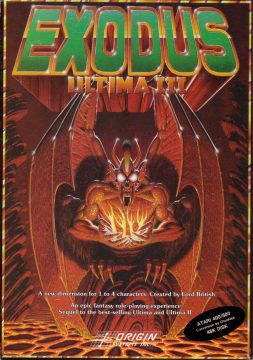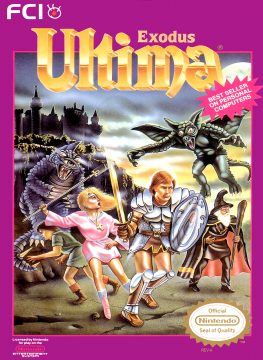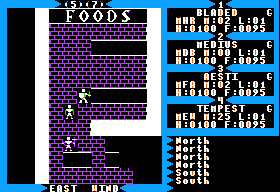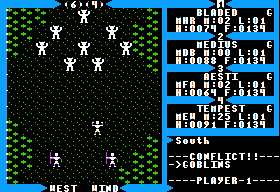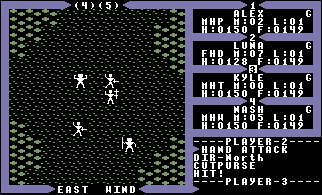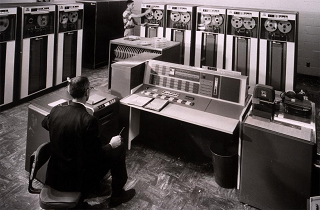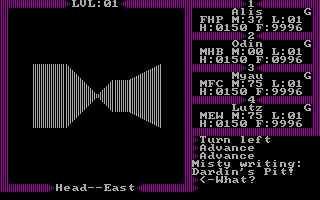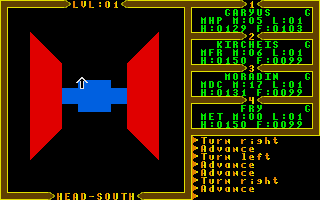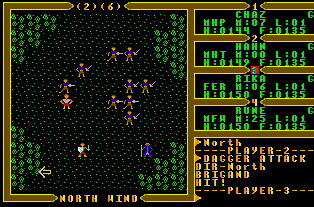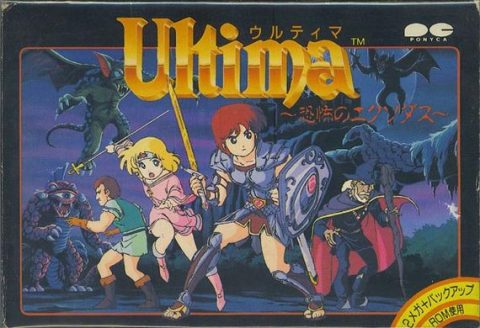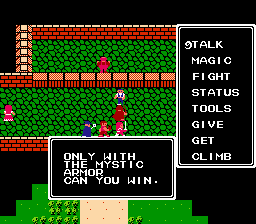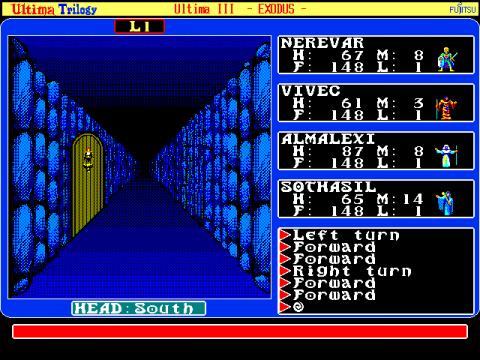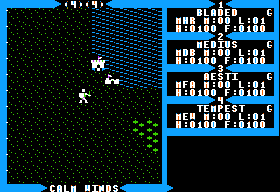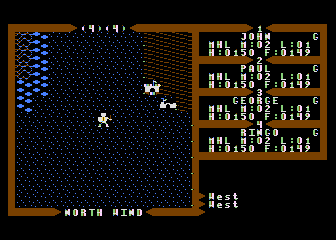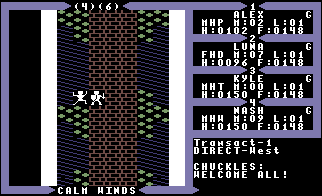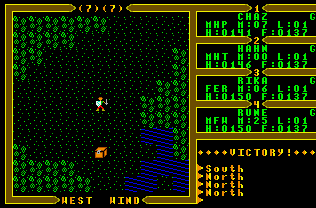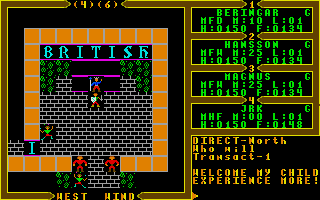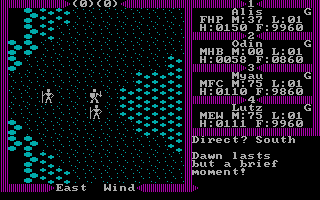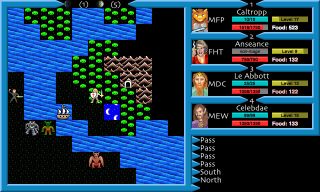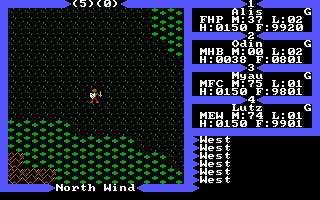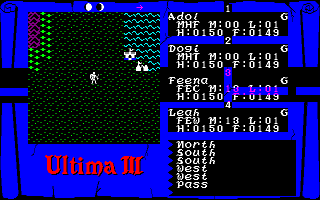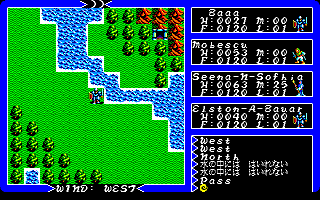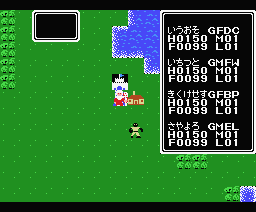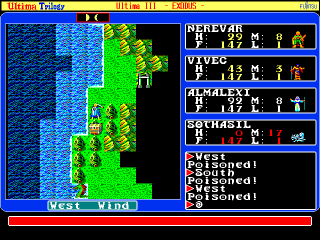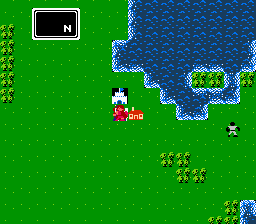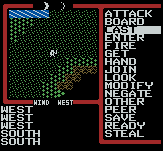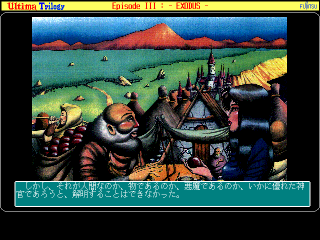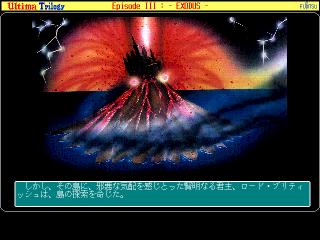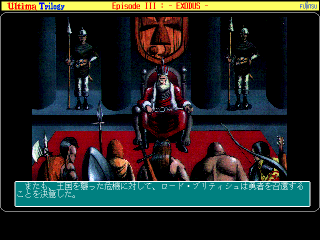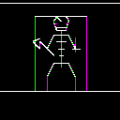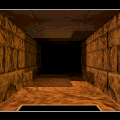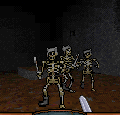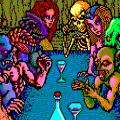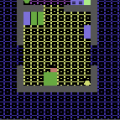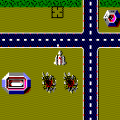- Ultima (Series Introduction)
- Akalabeth
- Ultima I: First Age Of Darkness
- Ultima II: Revenge of the Enchantress
- Ultima III: Exodus
- Ultima IV: Quest Of The Avatar
- Ultima V: Warriors of Destiny
- Ultima VII: The Black Gate
- Ultima VI: The False Prophet
- Ultima VII Part 2: Serpent Isle
- Ultima VIII: Pagan
- Ultima Underworld: The Stygian Abyss
- Ultima Underworld II: Labyrinth of Worlds
- Arx Fatalis
- Worlds of Ultima: The Savage Empire
- Ultima Worlds of Adventure 2: Martian Dreams
- Ultima IX: Ascension
- Lord of Ultima
- Ultima Online
- Ultima: Escape from Mt. Drash
- Ultima: Miscellaneous
- Richard Garriott (Interview)
From the depths of Hell, he comes for vengeance!
Such were the only words to escape the lips of the shattered man, found wandering outside Lord British’s castle. The sky darkens, an island of fire rises from the depths, and on the deck of a derelict ship a name is found written in blood: EXODUS. The foul offspring of Mondain and Minax comes forth to revenge itself upon the world, and your band of adventurers has answered the call to stop him!
Exodus is really the first game in the series to have aged well, and could be considered the first “modern” CRPG. As he usually did, Richard Garriott threw out all the old code for Revenge of the Enchantress and started fresh with the programming for Ultima III; he claims often in interviews that the point of these older games was to ‘teach Richard how to program’ and the focused concept, tight design and graphical and story advances make Exodus a joy to play even decades later. It?s a much more developed and more mature game, where the story for the first time is integral to the actual gameplay. Lord British has united Sosaria under his banner after the cataclysmic upheaval of Minax’ defeat, and is busy sending expeditions out to map the world when the darkness looms up stronger than ever before. A volcano has erupted out of the sea, and monsters once again roam the land, directed by an unseen malign intelligence whose name is discovered written in blood on a ghost ship: EXODUS. The half-demon, half-machine progeny of Mondain and Minax is stronger than either of his parents and has arrived in full force to bring doom to the lands that slew them. Genre-savvy Lord British hand-picks four heroic adventurers to go out and find a way to stop the monster Exodus, and along the way they’ll dive into dungeons, find exotic arms and armor, discover the sunken city of Ambrosia, meet with an immortal time lord, and ultimately challenge the beast to a final showdown in his castle on the Isle of Fire.
Exodus is the first game in the series to include adventuring parties, among many, many other additions and improvements which redeem the awkward Revenge of the Enchantress. The game opens with an impressive animated title screen, playing a movie of how the game works as a party of adventurers wanders and gets into trouble; this animated demo would remain in the series until Ultima VI, when it was replaced with cutscenes. Many of the graphics tiles are now animated, with lapping water, waving flags, and posing monsters and NPCs, giving the game world a far more lively look. Exodus features music composed by Ultima I co-creator Ken Arnold, becoming the first game in the series with a soundtrack. Combat is no longer an affair of just pressing (A)ttack and a direction to aim, but now takes place on a separate battlefield screen where you control each member of your party individually against bands of monsters in turn-based style. Victory in battle leaves a chest behind, usually trapped, a gameplay mechanic that later saw wide use in early Japanese console RPGs. The world of Exodus sets the trend that all later Ultimas would follow, to a stronger high fantasy feel, doing away with the science fiction elements of aliens, rocketships, phasers, time travel and power armor from previous games, with one notable exception.
Exodus begins with the creation of characters with which to form a party. There are more races and classes than before, which still for the most part follow the template of Dungeons & Dragons races and classes with humans, dwarves, hobbits (bobbits), fuzzies (think Ewok) and elves electing to become thieves, priests, magic-users and fighters or various combinations thereof (such as the alchemist, a sorcery-casting class with some thief ability). The goal of the game is again based primarily around diving into dungeons, this time to gather ‘marks’ which bestow new abilities on your party members. Monsters provide gold to spend in towns on equipment, items, and oracle and pub services. Victory leaves a chest on the overworld, seemingly always trapped, which you had best have your partymate with thief skills open. Dungeons are largely the same as in the previous games in the series, though with solid walls instead of vector graphics lines, and more features to be found like fountains or traps. Monster encounters in the dungeon are random, unlike previous games; walking will occasionally bring you to the combat screen like in the overworld, and there is no indication of monsters wandering ahead. Characters become more powerful with better equipment and higher statistics, and once prepared, they can storm the mysterious Fire Island and raid the castle of the evil Exodus to save Sosaria from Mondain’s legacy once and for all.
Exodus is a huge step up in game complexity from the previous hack-and-slash in another way as well, with an increased focus on NPC conversation and puzzles. Talking to NPCs becomes very important in Ultima III and remains a focus for the rest of the series, as it is only through dialogue that you get necessary information on finding supplies and needed gear, and help solving the puzzles of the hidden cities and Castle Exodus. Without knowing what to do, the game’s final ‘boss’ fight cannot be completed. The cloth map included with the game does not show locations of towns or dungeons, only the Sosarian landmass (a note in the expansive and in-character documentation mentions that the cartographer ‘vanished before finishing it’), requiring the player to explore for themselves and make notes on where points of interest can be found. Ultima III includes a line-of-sight feature similar to that now ubiquitous in strategy games, where your vision is blocked off by landscape features like mountains and forests, making finding some towns or dungeons a particular challenge. Like in previous games, statistic increases are purchased instead of earned through experience, and gold can be exchanged for stat increases, but only in a hidden city under the waves. The secret city of Ambrosia is accessible only via a mobile whirlpool that wanders the game world and is full of monsters, as well as ‘cards’ found at the various statistics-increasing shrines. Discovering Ambrosia is essential to game completion, as it is the only place to raise player statistics and the “cards” are required for the final fight against the evil Exodus.
This last part of the game is infamous for the nature of Exodus, who despite being depicted in dialogue and on Ultima III‘s box cover as a demonic gargoyle-like being, and described as the child of Mondain and Minax, turns out to actually be a sentient computer system. The cards found in the sunken city are computer punch-cards of the sort that were used in IBM’s hulking giant machines of mid-century, and must be entered into the system in the proper order to shut Exodus down and win the game. Victory results in a congratulatory message imploring the player to contact Origin and tell them about your deed, as well as being the story catalyst for vast changes in the Ultima world to come in later games.
Ultima III is an important title in computer game history, as it was the first release of a fledgling new developer founded by Richard Garriott, his brother Robert, and his high school friend (and Ultima port programmer) Charles “Chuckles” Bueche: Origin Systems, Inc.. After Garriott broke off from his deal with Sierra due to the perception that they were author-unfriendly and uncertainty whether they were dealing with him fairly, Origin Systems was first founded to publish Ultima and would later grow into one of the major computer game developers of the 1980s and 1990s. Starting a new software house was a risky venture. Fortunately, Ultima at this point was an established market presence that distributors did not feel wary about stocking, and the series continued to sell very well. Ultima III, along with the Wizardry games, also is ultimately the foundation of every one of the Famicom RPGs in the glut of role-playing games on that system, and therefore a part of it lies in every Eastern or JRPG ever. Ultima‘s overhead view with the large explorable overworld and tile-based graphics, combined with Wizardry‘s combat and relentless level grinding inspired Japanese developer Chunsoft and publisher Enix in 1986 to create the game Dragon Quest, which you may have heard of. Dragon Quest is practically unplayable by any decent standards nowadays, but the influence it had on the Japanese gaming industry is immeasureable; console RPG series like Final Fantasy, Phantasy Star, Star Ocean, Earthbound and Lunar all owe their existence directly to Dragon Quest and, in extension, Exodus.
Origin Systems originally released Exodus for the Apple II, Commodore 64, Atari 8-Bit and IBM PC platforms, with enhanced Macintosh, Atari ST and Amiga ports following several years later, and Japanese versions by Pony Canyon and Star Craft (best known for their collaboration with American company Broderbund and unrelated to the popular Activision strategy game). All ports are based on the Apple II version. Charles Bueche’s Commodore 64 version and “Banjo” Bob Hardy’s Atari 8-bit version are largely the same as the Apple II original, though of the 8-bit ports the C64’s excellent audio capabilities give it the edge (and slow loading takes it right back).
The Amiga and Atari ST ports, both by Banjo Bob and released quite a while afterward, are both largely identical to each other and by far superior in both graphics and sound quality to the other versions of the game, while the Macintosh version is similar to these but entirely grayscale. The 16-bit Amiga, Atari ST and Macintosh versions all include mouse support, making control rather smoother. Star Craft originally ported Ultima III to the FM-77, PC-88 and PC-98 in Japan, with few real differences from the western computer versions other than the necessities of different graphics hardware. Pony Canyon released their own PC-88, PC-98 and MSX2 disk version of the game with a different, more colorful tile set, like their previous entries in the series, with similar upgrades as their versions of Ultima II and I. The FM TOWNS version of the game, like the previous two, was released by Fujitsu as part of a special Ultima Trilogy disc in 1992, containing graphically and audibly upgraded versions of the games with a special introduction movie.
Ultima III received a IBM PC port written by James van Artsdalen, but like the Ultima II DOS version, it is absolutely atrocious. This edition of the game has the same CGA graphics issue as the previous game, no frame limiter, and no music. Like Ultima II, fortunately, a group of dedicated fans have come to the rescue, saving the game and putting it on par with the other 16-bit versions with MIDI music, 16-color EGA graphics and various other fixes. The upgrade has the same issues on Windows 7 as described for Ultima II‘s version.
Ultima III is the first of the games in the series to get a console release, being ported to the Famicom/NES by Origin in 1986 and published by FCI in North America and Japan. The NES version of Ultima III is the same basic game, but includes many changes. The graphics are replaced by anime-style drawings and the keyboard parser is replaced by a system of pop-up menus reminiscent of other NES/Famicom RPGs of the time like Dragon Warrior and Final Fantasy. This edition of Ultima III is strange-looking for someone used to the computer version and the controls are very awkward due to the low number of buttons on an NES controller, resulting in many menus that must be waded through in order to do anything in particular. The game’s interface has been almost completely removed, leaving the play area to occupy the entire screen, which can be taken as a positive point for people used to later-era RPGs that display more of the game world. The game’s dialogue is not especially helpful, making it hard to figure out what you’re supposed to be doing if you aren’t already familiar with it; many early console games had problems with both translation and with the limited space for long messages. The music is also rather grating. On the bright side, unlike Exodus, the game does not pass turns if you do nothing for too long, which makes combat far more fun when you have time to consider and plan without rushing to beat the turn limit. Pony Canyon’s first MSX2 version of Ultima IIIreleased a year after the Famicom is a port of a port, being identical to the Famicom edition of the game and released on MSX2 cartridge in 1988 (1989’s Pony Canyon MSX2 release is instead a port of the PC-88/98 games and released on disk). Ultima Exodus for the NES received a 64-page hint book, very difficult to find nowadays, containing artwork, a full game guide and a multi-page graphic novel introduction to the story-lines of the previous games in the series; scans of this hint book can be downloaded here.
In addition to the official ports of the game by Origin, Star Craft and Pony Canyon, there exist several more recent fan editions of the game. Programmer Sven Carlberg released a homebrew port of Ultima III to the Game Boy Color in 2001. The game uses a menu interface like the NES version, but is graphically and gameplay-wise much more like the computer ports than the NES/MSX. Commodore 64 demo group Big Floppy People have released an updated and bugfixed version of Ultima III for that console, which is called Ultima III Gold, containing several modifications to the game and a general cleanup of glitches, including much faster loading, faster graphics drawing, less awkward key controls and several built-in cheats to make some of the more tedious grinding for gold go by faster. But by far the best of these, and easily the definitive version of the game, is an Apple Macintosh port of Ultima III currently being sold by Lairware. The game has fantastic music quality, a choice of multiple different graphics sets (including the AppleII, C64, Mac Black & white, NES console and IBM PC versions as well as their own high-quality ‘modern’ graphics set), and an automated mode for combat to speed up the game. Lairware’s version is available for Mac OS X or older Mac OS as shareware (the sunken city Ambrosia cannot be visited except in the $5 paid-for version). Unfortunately, Lairware does not seem to offer a Windows version, or plan to offer one any time soon.
Links:
Ultima III Gold for Commodore 64
Ultima III for Game Boy Color (Open Source)
Ultima III fan upgrade
Lairware’s Macintosh version of Ultima III
Ultima III listing with guides and maps on GameFAQs
Fan site focusing on the NES port.
Replacement copy of the NES version’s manual
Purchase the Age of Darkness trilogy at Gog.com
Comparison Screenshots
Additional Screenshots – FM Towns

